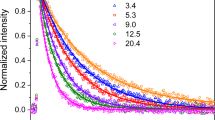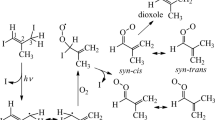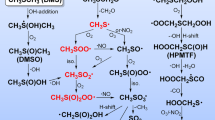Abstract
Formaldehyde, HCHO, is the highest-volume carbonyl in the atmosphere. It absorbs sunlight at wavelengths shorter than 330 nm and photolyses to form H and HCO radicals, which then react with O2 to form HO2. Here we show HCHO has an additional HO2 formation pathway. At photolysis energies below the energetic threshold for radical formation we directly detect HO2 at low pressures by cavity ring-down spectroscopy and indirectly detect HO2 at 1 bar by Fourier-transform infrared spectroscopy end-product analysis. Supported by electronic structure theory and master equation simulations, we attribute this HO2 to photophysical oxidation (PPO): photoexcited HCHO relaxes non-radiatively to the ground electronic state where the far-from-equilibrium, vibrationally activated HCHO molecules react with thermal O2. PPO is likely to be a general mechanism in tropospheric chemistry and, unlike photolysis, PPO will increase with increasing O2 pressure.

This is a preview of subscription content, access via your institution
Access options
Access Nature and 54 other Nature Portfolio journals
Get Nature+, our best-value online-access subscription
$29.99 / 30 days
cancel any time
Subscribe to this journal
Receive 12 print issues and online access
$259.00 per year
only $21.58 per issue
Buy this article
- Purchase on Springer Link
- Instant access to full article PDF
Prices may be subject to local taxes which are calculated during checkout





Similar content being viewed by others
Data availability
All data are available in the paper or the supplementary materials. Source data are available for Figs. 2, 3, 4 and 5. Source data are provided with this paper.
References
Finlayson-Pitts, B. J. & Pitts, J. N. Jr Chemistry of the Upper and Lower Atmosphere: Theory, Experiments, and Applications (Academic Press, 2000).
Atkinson, R. & Arey, J. Atmospheric degradation of volatile organic compounds. Chem. Rev. 103, 4605–4638 (2003).
Glowacki, D. R. et al. Interception of excited vibrational quantum states by O2 in atmospheric association reactions. Science 337, 1066–1069 (2012).
Vaida, V. & Donaldson, D. J. Red-light initiated atmospheric reactions of vibrationally excited molecules. Phys. Chem. Chem. Phys. 16, 827–836 (2014).
Tully, J. C. Reactions of O(1D) with atmospheric molecules. J. Chem. Phys. 62, 1893–1898 (1975).
Ruscic B. & Bross, D. H. Active Thermochemical Tables v. 1.124 (Argonne National Laboratory, accessed 20 December 2022); https://atct.anl.gov/
Houston, P. L. & Moore, C. B. Formaldehyde photochemistry: appearance rate, vibrational relaxation, and energy distribution of the CO product. J. Chem. Phys. 65, 757–770 (1976).
Chuang, M.-C., Foltz, M. F. & Moore, C. B. T1 barrier height, S1–T1 intersystem crossing rate, and S0 radical dissociation threshold for HCHO, D2CO, and HDCO. J. Chem. Phys. 87, 3855–3864 (1987).
Valachovic, L. R. et al. Photoinitiated HCHO unimolecular decomposition: accessing H + HCO products via S0 and T1 pathways. J. Chem. Phys. 112, 2752–2761 (2000).
Townsend, D. et al. The roaming atom: straying from the reaction path in formaldehyde decomposition. Science 306, 1158–1161 (2004).
Troe, J. Analysis of quantum yields for the photolysis of formaldehyde at λ > 310 nm. J. Phys. Chem. A 111, 3868–3874 (2007).
Quinn, M. S. et al. Rotational resonances in the HCHO roaming reaction are revealed by detailed correlations. Science 369, 1592–1596 (2020).
Quinn, M. S., Andrews, D. U., Nauta, K., Jordan, M. J. T. & Kable, S. H. The energy dependence of CO(v,J) produced from via the transition state, roaming, and triple fragmentation channels. J. Chem. Phys. 147, 013935 (2017).
Feller, D., Dupuis, M. & Garrett, B. C. Barrier for the HCHO → H2 + CO reaction: a discrepancy between high-level electronic structure calculations and experiment. J. Chem. Phys. 113, 218–226 (2000).
Bauerfeldt, G. F., de Albuquerque, L. M. M., Arbilla, G. & da Silva, E. C. Unimolecular reactions on formaldehyde S0 PES. J. Molec. Struct. (Theochem) 580, 147–160 (2002).
Zhang, X., Rheinecker, J. L. & Bowman, J. M. Quasiclassical trajectory study of formaldehyde unimolecular dissociation: HCHO → H2 + CO, H + HCO. J. Chem. Phys. 122, 114313 (2005).
Harding, L. B., Klippenstein, S. J. & Jasper, A. W. Ab initio methods for reactive potential surfaces. Phys. Chem. Chem. Phys. 9, 4055–4070 (2007).
Clark, J. H., Moore, C. B. & Nogar, N. S. The photochemistry of formaldehyde: absolute quantum yields, radical reactions, and NO reactions. J. Chem. Phys. 68, 1264–1271 (1978).
Horowitz, A. & Calvert, J. G. Wavelength dependence of the quantum efficiencies of the primary processes in formaldehyde photolysis at 25 °C. Int. J. Chem. Kin. 10, 805–819 (1978).
Moortgat, G. K., Šlemr, F., Seiler, W. & Warneck, P. Relative quantum yields of H2 and CO in the wavelength range 70–360 nm. Chem. Phys. Lett. 54, 444–447 (1978).
Moortgat, G. K. & Warneck, P. CO and H2 quantum yields in the photodecomposition of formaldehyde in air. J. Chem. Phys. 70, 3639–3651 (1979).
Moortgat, G. K., Seiler, W. & Warneck, P. Photodissociation of HCHO in air: CO and H2 quantum yields at 220 and 300 K. J. Chem. Phys. 78, 1185–1190 (1983).
Smith, G. D., Molina, L. T. & Molina, M. J. Measurement of radical quantum yields from formaldehyde photolysis between 269 and 339 nm. J. Phys. Chem. A 106, 1233–1240 (2002).
Atkinson, R. et al Evaluated kinetic and photochemical data for atmospheric chemistry: volume II gas phase reactions of organic species. Atmos. Chem. Phys. 6, 3625–4055 (2006); http://iupac.pole-ether.fr. Datasheet updated: 16 April 2013; last change in preferred values: 16 April 2013.
Campbell, J. S., Nauta, K., Hansen, C. S. & Kable, S. H. POPTARTS: a new method to determine quantum yields in a molecular beam. J. Phys. Chem. A 126, 9268–9275 (2022).
Su, F., Calvert, J. G. & Shaw, J. H. Mechanism of the photooxidation of gaseous formaldehyde. J. Phys. Chem. 83, 3185–3191 (1979).
Terentis, A. C., Waugh, S. E., Metha, G. F. & Kable, S. H. HCO (N, Ka, Kc, J) distributions from near-threshold photolysis of HCHO (J, Ka, Kc). J. Chem. Phys. 108, 3187–3198 (1998).
Assaf, E., Liu, L., Schoemaecker, C. & Fittschen, C. Absorption spectrum and absorption cross sections of the 2ν1 band of HO2 between 20 and 760 torr air in the range 6636 and 6639 cm−1. J. Quant. Spectrosc. Radiat. Transf. 211, 107–114 (2018).
Shaw, M. F. et al. Photo-tautomerization of acetaldehyde as a photochemical source of formic acid in the troposphere. Nat. Commun. 9, 2584 (2018).
Clouthier, D. J. & Ramsay, D. A. The spectroscopy of formaldehyde and thioformaldehyde. Annu. Rev. Phys. Chem. 34, 31–58 (1983).
Motsch, M. et al. Spectroscopy of the A1A2–X1A1 transition of formaldehyde in the 30140–30790 cm–1 range: the 210430 and 220410 rovibrational bands. J. Molec. Spectrosc. 252, 25–30 (2008).
Jenkin, M. E., Hurley, M. D. & Wallington, T. J. Investigation of the radical product channel of the CH3C(O)O2 + HO2 reaction in the gas phase. Phys. Chem. Chem. Phys. 9, 3149–3162 (2007).
Morajkar, P., Schoemaecker, C., Okumura, M. & Fittschen, C. Direct measurement of the equilibrium constants of the reaction of formaldehyde and acetaldehyde with HO2 radicals. Int. J. Chem. Kinet. 46, 245–259 (2014).
Bixon, M. & Jortner, J. Intramolecular radiationless transitions. J. Chem. Phys. 48, 715–726 (1968).
Weisshaar, J. C. & Moore, C. B. Isotope, electric field, and vibrational state dependence of single rotational level lifetimes of S1 formaldehyde. J. Chem. Phys. 72, 5415–5425 (1980).
Yin, H. M., Kable, S. H. X. & Bowman, J. M. Signatures of HCHO photodissociation from two electronic states. Science 311, 1443–1446 (2006).
Miller, R. G. & Lee, E. K. C. Single vibronic level photochemistry of formaldehydes in the à 1A2 state: radiative and nonradiative processes in HCHO, HDCO, and D2CO. J. Chem. Phys. 68, 4448–4464 (1978).
Huynh, L. K., Tirtowidjojo, M. & Truong, T. N. Theoretical study on kinetics of the HCHO + O2 → HCO + HO2 reaction. Chem. Phys. Lett. 469, 81–84 (2009).
Michael, J. V., Kumaran, S. S. & Su, M.-C. Rate constants for CH3 + O2 → CH3O + O at high temperature and evidence for HCHO + O2 → HCO + HO2. J. Phys. Chem. A 103, 5942–5948 (1999).
Vasudevan, V., Davidson, D. F., Hanson, R. K., Bowman, C. T. & Golden, D. M. High-temperature measurements of the rates of the reactions CH2O + Ar → products and CH2O + O2 → products. Proc. Combust. Inst. 31, 175–183 (2007).
Hidaka, Y. et al. Shock-tube study of CH2O pyrolysis and oxidation. Combust. Flame 92, 365–376 (1993).
Eiteneer, B., Yu, C.-L., Goldenberg, M. & Frenklach, M. Determination of rate coefficients for reactions of formaldehyde pyrolysis and oxidation in the gas phase. J. Phys. Chem. A 102, 5196–5205 (1998).
Srinivasan, N. K., Su, M.-C., Sutherland, J. W. & Michael, J. V. Reflected shock tube studies of high-temperature rate constants for CH3 + O2, HCHO + O2, and OH + O2. J. Phys. Chem. A 109, 7902–7914 (2005).
Maranzana, A., Barker, J. R. & Tonachini, G. Master equation simulations of competing unimolecular and bimolecular reactions: application to OH production in the reaction of acetyl radical with O2. Phys. Chem. Chem. Phys. 9, 4129–4141 (2007).
Barker, J. R., et al. MultiWell-2022 Software Suite (University of Michigan, 2022); http://clasp-research.engin.umich.edu/multiwell/
Barker, J. R. Multiple-well, multiple-path unimolecular reaction systems. I. MultiWell computer program suite. Int. J. Chem. Kinet. 33, 232–245 (2001).
Barker, J. R. Energy transfer in master equation simulations: a new approach. Int. J. Chem. Kinet. 41, 748–763 (2009).
Zhang, X., Zou, S., Harding, L. B. & Bowman, J. M. A global ab Initio potential energy surface for formaldehyde. J. Phys. Chem. A. 108, 8980–8986 (2004).
Maeda, S., Ohno, K. & Morokuma, K. Automated global mapping of minimal energy points on seams of crossing by the anharmonic downward distortion following method: a case study of H2CO. J. Phys. Chem. A 113, 1704–1710 (2009).
Lahankar, S. A., Chambreau, S. D., Zhang, X., Bowman, J. M. & Suits, A. G. Energy dependence of the roaming atom pathway in formaldehyde decomposition. J. Chem. Phys. 126, 044314 (2007).
Morajkar, P., Bossolasco, A., Schoemaecker, C. & Fittschen, C. Photolysis of CH3CHO at 248 nm: evidence of triple fragmentation from primary quantum yield of CH3 and HCO radicals and H atoms. J. Chem. Phys. 140, 214308 (2014).
Stone, D., Whalley, L. K. & Heard, D. E. Tropospheric OH and HO2 radicals: field measurements and model comparisons. Chem. Soc. Rev. 41, 6348–6404 (2012).
Staak, M., Gash, E. W., Venables, D. S. & Ruth, A. A. The rotationally-resolved absorption spectrum of formaldehyde from 6547 to 6804 cm–1. J. Mol. Spectrosc. 229, 115–121 (2005).
Ruth, A. A., Heitmann, U., Heinecke, E. & Fittschen, C. The rotationally resolved absorption spectrum of formaldehyde from 6547 to 7051 cm–1. Z. Phys. Chem. 229, 1609–1624 (2015).
Western, C. M. PGOPHER, a program for simulating rotational, vibrational and electronic spectra. J. Quant. Spectrosc Radiat. Transfer 186, 221–242 (2017).
Frisch, M. J. et al. Gaussian 16, revision C.01 (Gaussian, Inc., 2016).
Truhlar, D. G., Steckler, R. & Gordon, M. S. Potential energy surfaces for polyatomic reaction dynamics. Chem. Rev. 87, 217–236 (1987).
Durant, J. L. Evaluation of transition state properties by density functional theory. Chem. Phys. Lett. 256, 595–602 (1996).
Shaw, M. F. Photochemical Formation of Enols from Carbonyls. PhD thesis, The Univ. Sydney (2017).
Rowell, K. N., Kable, S. H. & Jordan, M. J. T. Structural effects on the Norrish type I α‐bond cleavage of tropospherically important carbonyls. J. Phys. Chem. A 123, 10381–10396 (2019).
Rowell, K. N., Kable, S. H. & Jordan, M. J. T. An assessment of the tropospherically accessible photo-initiated ground state chemistry of organic carbonyls. Atmos. Chem. Phys. 2022, 929–949 (2022).
Johnson, R. D. III (ed.) NIST Computational Chemistry Comparison and Benchmark Database, NIST Standard Reference Database Number 101 Release 21, August 2020 (CCCBDB, accessed 1 march 2021); http://cccbdb.nist.gov/
Lubic, K. G., Amano, T., Uehara, H., Kawaguchi, K. & Hirota, E. The ν1 band of the DO2 radical by difference frequency laser and diode laser spectroscopy: the equilibrium structure of the hydroperoxyl radical. J. Chem. Phys. 81, 4826–4831 (1984).
Herzberg, G. Electronic Spectra and Electronic Structure of Polyatomic Molecules (Van Nostrand Reinhold, 1966).
Huber K. P. & Herzberg, G. Molecular Spectra and Molecular Structure IV. Constants of Diatomic Molecules (Van Nostrand Reinhold, 1979).
Duncan, J. L. The ground-state average and equilibrium structures of formaldehyde and ethylene. Mol. Phys. 28, 1177–1191 (1974).
Laury, M. L. et al. Harmonic vibrational frequencies: scale factors for pure, hybrid, hybrid meta, and double-hybrid functionals in conjunction with correlation consistent basis sets. J. Comp. Chem. 32, 2339–2347 (2011).
Kesharwani, M. K., Brauer, B. & Martin, J. M. L. Frequency and zero-point vibrational energy scale factors for double-hybrid density functionals (and other selected methods): can anharmonic force fields be avoided? J. Phys. Chem. A 119, 1701–1714 (2015).
Tardy, D. C. & Rabinovitch, B. S. Intermolecular vibrational energy transfer in thermal unimolecular systems. Chem. Rev. 77, 369–408 (1977).
Weaver, A. B. & Alexeenko, A. A. Revised variable soft sphere and Lennard–Jones model parameters for eight common gases up to 2200 K. J. Phys. Chem. Ref. Data 44, 023103 (2015).
Troe, J. Theory of thermal unimolecular reactions at low pressures. I. Solutions of the master equation. J. Chem. Phys. 66, 4745–4757 (1977).
Acknowledgements
We thank C. Hecquet and C. Schoemaecker for assistance with the Lille photolysis laser. B.A.W. and M.E.C. acknowledge Australian Government Research Training Scheme scholarships. Funding: Australian Research Council grant DP190102013 (B.A.W., M.E.C., P.S., K.N., M.J.T.J., S.H.K.); French ANR agency under contract number ANR-11-Labx-0005-01 CaPPA (Chemical and Physical Properties of the Atmosphere) (E.A., C.F.); Région Hauts-de-France, the Ministère de l’Enseignement Supérieur et de la Recherche (CPER Climibio) (E.A., C.F.); European Fund for Regional Economic Development (E.A., C.F.). Computation was supported with the assistance of resources from the National Computational Infrastructure (NCI Australia), an NCRIS-enabled capability supported by the Australian Government (M.E.C., M.J.T.J.).
Author information
Authors and Affiliations
Contributions
Conceptualization: M.J.T.J. and S.H.K. Methodology and investigation: B.A.W., M.E.C., E.A., K.N., P.S., M.J.T.J., C.F. and S.H.K. Funding acquisition and project administration: M.J.T.J., C.F. and S.H.K. Supervision: K.N., M.J.T.J., C.F. and S.H.K. Writing—original draft: M.J.T.J. and S.H.K. Writing—review and editing: B.A.W., M.E.C., E.A., K.N., P.S., M.J.T.J., C.F. and S.H.K.
Corresponding authors
Ethics declarations
Competing interests
The authors declare no competing interests.
Peer review
Peer review information
Nature Chemistry thanks A. R. Ravishankara, Paul Seakins and the other, anonymous, reviewer(s) for their contribution to the peer review of this work.
Additional information
Publisher’s note Springer Nature remains neutral with regard to jurisdictional claims in published maps and institutional affiliations.
Supplementary information
Supplementary Information
Supplementary Methods and discussion, Figs. 1–12 and Tables 1–8.
Source data
Source Data Fig. 2
CRDS spectrum and simulation data.
Source Data Fig. 3
CRDS spectrum and master equation modelling data.
Source Data Fig. 4
FTIR spectrum data.
Source Data Fig. 5
Rate coefficient, CRDS and master equation modelling data.
Rights and permissions
Springer Nature or its licensor (e.g. a society or other partner) holds exclusive rights to this article under a publishing agreement with the author(s) or other rightsholder(s); author self-archiving of the accepted manuscript version of this article is solely governed by the terms of such publishing agreement and applicable law.
About this article
Cite this article
Welsh, B.A., Corrigan, M.E., Assaf, E. et al. Photophysical oxidation of HCHO produces HO2 radicals. Nat. Chem. 15, 1350–1357 (2023). https://doi.org/10.1038/s41557-023-01272-4
Received:
Accepted:
Published:
Issue Date:
DOI: https://doi.org/10.1038/s41557-023-01272-4
This article is cited by
-
Photophysical oxidation of atmospheric carbonyls
Nature Chemistry (2023)



